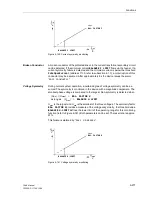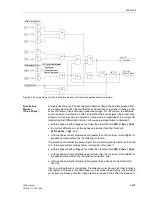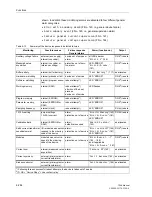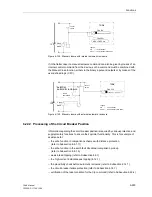
Functions
6-278
7SA6 Manual
C53000-G1176-C156-2
Voltage Phase
Rotation
The verification of the faulted phases and the phase preference, direction measure-
ment and polarization with quadrature voltages usually demand clockwise rotation of
the measured values. The phase rotation of the measured voltages is checked by
monitoring of the voltage phase sequence.
U
L1
before U
L2
before U
L3
This check takes place if each measured voltage has a minimum magnitude of
|U
L1
|, |U
L2
|, |U
L3
| > 40 V/
√
3
In the event of negative phase rotation, the alarm “
Fail Ph. Seq.
” is issued.
If the system has a negative phase rotation, this must have been set during the con-
figuration of the power system data (Sub-section 6.1.1). In such event, the phase ro-
tation monitoring applies to the corresponding opposite phase sequence.
Fuse Failure
Monitor
(Non-Symmetrical
Voltages)
In the event of measured voltage failure due to a short circuit or broken conductor in
the voltage transformer secondary circuit certain measuring loops may mistakenly see
a voltage of zero, which due to the load current may result in an unwanted pick-up or
even trip.
If a VT miniature circuit breaker (mcb) with correspondingly adjusted auxiliary contacts
is not available, but instead e.g. fuses are used, the fuse failure monitor may be acti-
vated. Naturally, it is also possible to use voltage transformer mcb and fuse failure
monitor at the same time.
The non-symmetrical measured voltage failure is characterized by its voltage unsym-
metry with simultaneous current symmetry. In Figure 6-142 the logic diagram of the
fuse failure monitor during unsymmetrical failure of the measured voltage is shown.
If there is substantial voltage unsymmetry of the measured values, without unsymme-
try of the currents being registered at the same time, this indicates the presence of a
non-symmetrical failure in the voltage transformer secondary circuit.
The unsymmetry of the voltage is detected by the fact that either the zero sequence
voltage or the negative sequence voltage exceed a settable value
FFM U>(min)
. The
current is assumed to be sufficiently symmetrical, if both the zero sequence as well as
the negative sequence current are below the settable threshold
FFM I< (max)
.
As soon as this state is recognized, the distance protection and all other functions that
operate on the basis of undervoltage (e.g. also weak infeed tripping, undervoltage pro-
tection) are blocked. The immediate blocking demands current flow in at least one of
the phases. The distance protection may be switched over to definite time overcurrent
emergency operation if the overcurrent protection was configured accordingly (refer to
Section 6.11).
The fast blocking may not occur as long as one phase is without voltage due to a
single-pole dead time condition before auto-reclosure, as the non-symmetry of the
measured values arising in this state is due to the switching state of the line and not
due to a failure in the secondary circuits. Accordingly, the fast blocking is disabled
when the line is tripped single-pole (internal information “1pole open” in the logic dia-
gram).
If a zero sequence or negative sequence current is detected within approximately 10 s
after recognition of this criterion, the protection assumes a short-circuit and removes
the blocking by the fuse failure monitor for the duration of the fault. If on the other hand
the voltage failure criterion is present for longer than approx. 10 s, the blocking is per-
manently activated (latching of the voltage criterion after 10 s). Only once the voltage
criterion is removed by correction of the secondary circuit failure, will the blocking au-
tomatically reset, thereby releasing the blocked protection functions again.
Summary of Contents for siprotec 7SA6
Page 2: ...Siemens Aktiengesellschaft Book No C53000 G1176 C156 2 ...
Page 18: ...xviii 7SA6 Manual C53000 G1176 C156 2 ...
Page 32: ...Introduction 1 14 7SA6 Manual C53000 G1176 C156 2 ...
Page 82: ...Hardware and Connections 2 50 7SA6 Manual C53000 G1176 C156 2 ...
Page 119: ...SIPROTEC 4 Devices 4 25 7SA6 Manual C53000 G1176 C156 2 Figure 4 20 CFC Logic example ...
Page 190: ...Configuration 5 62 7SA6 Manual C53000 G1176 C156 2 ...
Page 652: ...Installation and Commissioning 8 78 7SA6 Manual C53000 G1176 C156 2 ...
Page 724: ...Technical Data 10 56 7SA6 Manual C53000 G1176 C156 ...
Page 800: ...Appendix A 76 7SA6 Manual C53000 G1176 C156 2 ...
Page 866: ...Appendix B 66 7SA6 Manual C53000 G1176 C156 2 ...






























